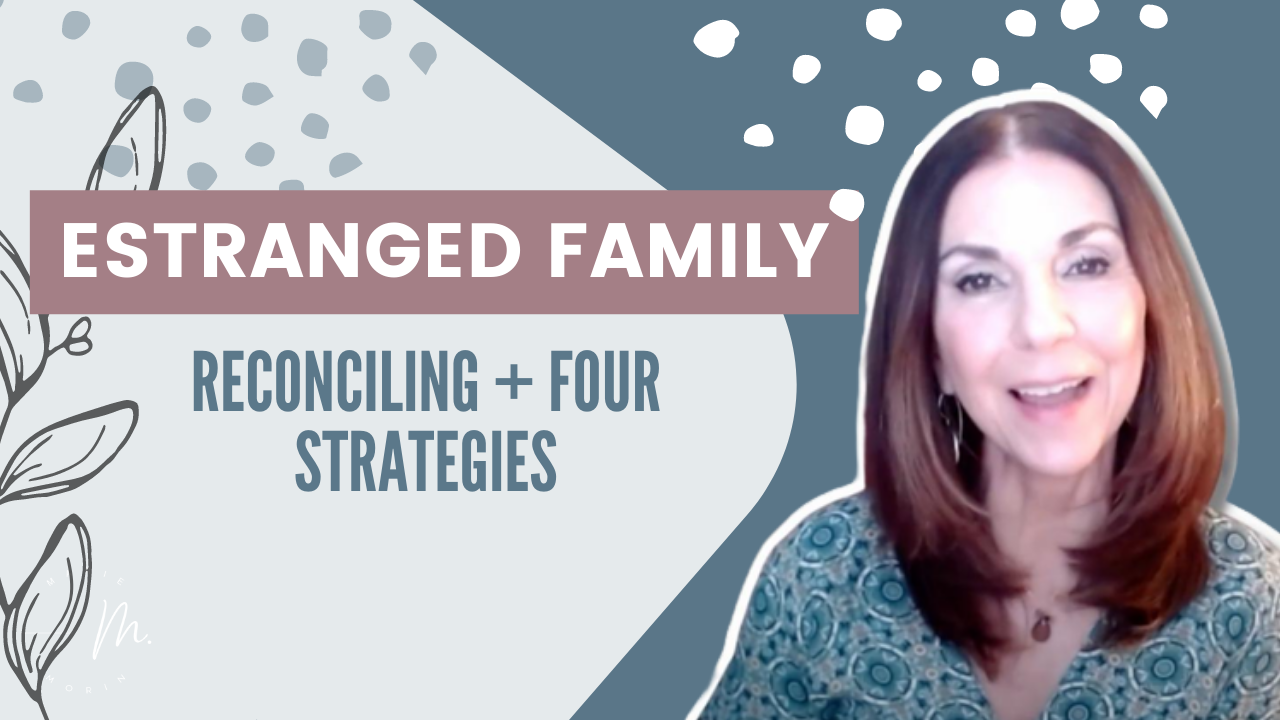Reconciling is a means to move out of the separation of estrangement and find a path forward for a new connected relationship. Estrangement stories and experiences characteristically are varied and very complicated.
There is no one size fits all solution and no simple method for the outcome of resuming a relationship. However, successful reconcilers practiced four key strategies as they journeyed towards reconciliation. This article discusses Reconciling With Estranged Family Members and Four Strategies For Reconciliation.
The emotional and or physical distance can take its toll on the estranged. Cut-off individuals from one or more family members can feel the emotional, physical, and social effects regardless of who initiated it.
Nearly everyone I speak to wants to reconcile. For some, reconciliation is impossible or unsafe, and estrangement is a necessary self-preserving act. Reconciling when it is safe and you are ready is a courageous act.
What is Reconciling When There is Estrangement
To reconcile is to make amends, settle a dispute, and call for a cease-fire. Often there is no way to reconcile the two versions, and reconciliation is accepting that fact. Reconcilers of estrangement were willing to relinquish needing to win their point. To reconcile when there are two opposing viewpoints relates to one’s resigning the need for both sides to agree on one narrative.
A considerable obstacle when considering reconciling is the insistence that the other party listens and agrees with your version of the past. Indeed, both parties’ versions are valid and deserve attention. Estrangement is complex and filled with versions tied to painful histories.
Many threads within a family rift may include divorce, emotional abandonment, alienation, mental illness and substance use, and long-standing poor communication. The differing threads of the dark tapestry being cut off participate in its design.
To reconcile, one must focus not on the threads that created the mess but on what the new relational tapestry will reveal.
It makes a lot of sense to desire reconciliation if possible and safe. For some, reconciling is not an option because the other is not ready, or the relationship is unsafe. Estrangement carries the intense emotions of grief, such as anger and depression. There may be a focus on frequent reviews of others or their past behaviors and words. There may be a need to have the other take responsibility and apologize.
No doubt that the dark nature of being cut off and feeling discarded illicit internal dialogue to make sense of what happened. Estrangement can happen on a spectrum where the level of connection diminishes over time. Often, an explosive event occurs with extremely hurtful words, threats, and negative evaluations. Each party makes meaning of what happened and creates a narrative based on their perceptions from their unique lens. In other words, there are two sides to the story, and each report makes sense for them individually. The four strategies to reconcile originate from Dr. Karl Pillemer’s book, Fault Lines Fractured Families and How to Mend Them.
Four Strategies To Reconciling
1. Accept that Your Version of the Past will not Align with Theirs.
Each estranged person has their version and their unique understanding of what occurred and may continue to occur. Making sense of the matter creates our narrative and perspective. Pillemer interviewed reconcilers and found they were willing to let of the need to get the other to align with their version of the past.
2 Abandon the Need For an Apology
Abby, not her real name, told me her story of being estranged from her mom on and off for years. Abby’s mom, stuck in the past and trying to figure out what had caused her daughter to estrange, could not fully listen. Mom pointed to Abby’s behaviors that created the rift between them. Abby changed her approach after several failed attempts to reconcile. To avoid being estranged again, Abby learned to find her calm, recognize her mom’s triggers, and communicate her feelings toward her mom.
Abby waited for her mom to be receptive, and without accusing, she told her mom she perceived she was unloved. Abby witnessed her drained mom from her dedication to her extended family.
Abby explains, “to avoid future estrangements; I was able to recognize the triggers and change my approach. In what seemed like her futile attempts to understand why things happened as they did, I knew she would continue to dwell on the past. When she inevitably did, I was finally able to calmly crystallize (better communicate) what needed to be said all along. As a kid, I didn’t feel loved due to (emphasized) my perception that her energies were spent on issues between extended family, leaving her emotionally drained and unavailable for me.”
Abby released her need to gain an apology.
She shared, “she didn’t apologize, but in reaching out and holding my hand, she didn’t need to.”
In this story, Abby did the transforming by learning how to communicate better so her version and perceptions of the past were “crystalized” calmly so her mom could hear them. Abby abandoned a need for an apology.
Consider if insisting your estranged family member needs to take responsibility and apologize is blocking the chance for reconciling.
3. Build a Future
Each estranged individual has unique perceptions and narratives. In time, the description may harden to such an extent that requiring an apology or resurrection of what had occurred is futile.
Reconcilers were able to find changes in their family members, perhaps their softened communication or their subtle cues that they also desired to step into the future with them.
Reconcilers knew that rehashing long-standing behaviors would not be productive in their quest to build a future with their loved ones. Interestingly, when many of the reconcilers reflected on their perceptions and the relationship, there were familiar things they both enjoyed.
The association had strengths and areas in which they could now build a future. They can do simple activities such as going to a movie, gardening together, and going for walks.
Pillers interviewees described how they focused on pleasantries and avoided conversations that would trigger either of them. For some, there were expressions of remorse, and in time, some did apologize.
4. Living Life Forward
The need for an apology and rehashing the past will not help when your goal is to reconcile.
What reconcilers understand is that there is an acceptance and intention in the benefit of reconciling. The acceptance is that the past remains behind you. The choice is to look forward to what your relationship will now become.
In other words, reconcilers found their wisdom by analyzing and reflecting on their part in the relationship. They also decided to interpret and explain the estrangement through a different lens.
Perhaps they even found more empathy for their loved ones. In this way, they constructed a different narrative. They were willing to change their communication patterns. Most importantly, the old ways of communicating and relating change; people change in time.
Reconcilers also began taking care of themselves. They are careful to examine their mindfulness and self-care. They use daily practices such as eating and sleeping well, daily movement practice, yoga, meditation, and prayer.
The estranged who want to heal and move forward are socially active with people who love and value them. They also find support from a therapist and can freely talk about their past, present, and future concerns.
Consider learning and practicing communication skills that will help you in your journey. Choose to live joyfully despite the separation from your loved one.
Reconciling is a means to move out of the separation of estrangement and find a path forward for a new connecting relationship. Estrangement stories and experiences are characteristically varied and very complicated.
There is no one size fits all solution and no simple path to the outcome of resuming a relationship. However, successful reconcilers practiced four key strategies, including journeying towards reconciliation. This article discusses Reconciling With Estranged Family Members and Four Strategies For Reconciliation
Get The eBook: Feeling Heartbroken and Alone? How to Pick Up the Pieces When You are Estranged.
Resources:
- Agllias, Kylie. Family Estrangement A Matter Of Perspective. New York, Routledge, 2017.
- Coleman, Joshua. Rules of Estrangement. New York, Harmony Books, 2020.
- Morin, Marie. Feeling Heartbroken and Alone? How to Pick Up the Pieces When You are Estranged. eBook. 2022.
- Morin, M.L. [Morin Holistic Therapy]. (2022, January 4 ). What is Family Estrangement? You Are Not Alone.
- Morin, M.L. [Morin Holistic Therapy]. (2021, September 8). Diaphragmatic Breathing: 5 Minute Deep Breathing Exercise for Beginners.
- Morin, Marie. How to Deal with Estranged Family During the Holidays (2021, November 21) Sixty and Me. https://sixtyandme.com/estranged-family-holidays/
- Pillemer, Karl. Fault Lines Fractured Families and How to Mend Them. New York Penguin Random House, 2020.





